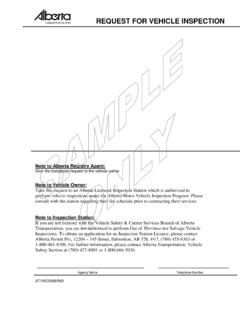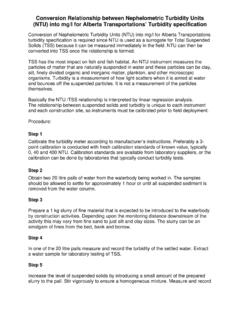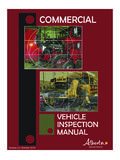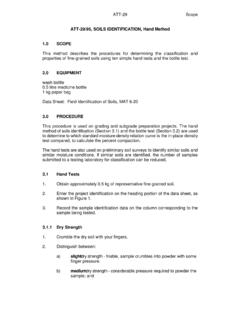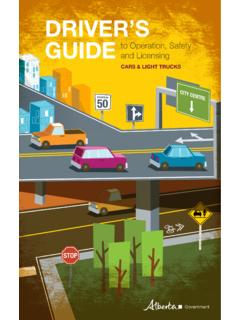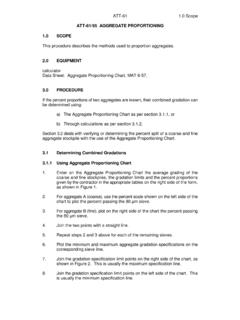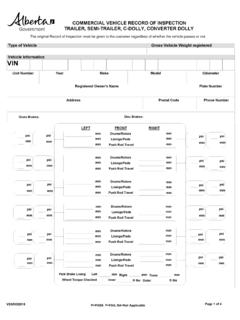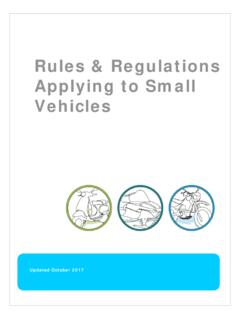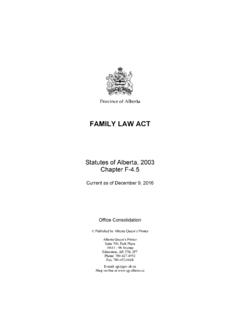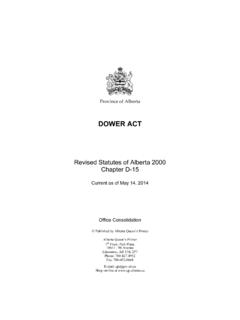Transcription of Recreational Vehicle Towing Guide - Alberta
1 Recreational Vehicle Towing Guide 2 TABLE OF CONTENTS HOW TO DETERMINE THE GROSS Vehicle WEIGHT RATING FOR Recreational VEHICLES Terms and Definitions .. 2 Conversion .. 3 Net 4 Manufacturer Gross Vehicle Weight Rating .. 4 Vehicle 4 Trailer Gross Vehicle Weight Rating .. 4 EXAMPLES Truck and Camper Unit .. 5 Truck Towing Recreational Trailer .. 6 CALCULATE YOUR VEHICLES 7 KEY FACTORS TO 7 BREAKING REQUIREMENTS FOR TRAILERS When are Brakes Required on Trailers? .. 8 Types of Brake 8 Trailer Breakaway Device .. 8 9 Towing NUMEROUS DISCLAIMER This Guide applies to Alberta only; other province s regulations may differ. This Guide applies solely to the non-commercial operation of trailers.
2 Trailer combinations operated for commercial purposes are governed by different regulations and standards. HOW TO DETERMINE GROSS Vehicle WEIGHT RATINGS FOR Recreational VEHICLES If hauling a camper unit, Towing a trailer or fifth wheel, the following steps will help you in determining what your Vehicle is capable of Towing or hauling. This Guide is intended to assist you. Should conflict arise please refer to the Traffic Safety Act and its regulations which can be viewed online at the Queen s Printer Terms and Definitions Gross Axle Weight Rating (GAWR) ; the GAWR refers to the maximum weight an axle is designed to carry. The GAWR is a safety standard used to prevent overloading.
3 3 Manufacturers set the Gross Axle Weight Rating based on requirements set by Transport Canada. Gross Vehicle Weight Rating (GVWR) ; the GVWR refers to the maximum weight a Vehicle is designed to carry including the net weight of the Vehicle with accessories, plus the weight of passengers, fuels, and cargo. The GVWR is a safety standard used to prevent overloading. Manufacturers set the GVWR based on requirements set by Transport Canada. The weight on an axle can vary depending on where items are stored. Gross Combination Weight Rating (GCWR) ; the GCWR, sometimes expressed as the maximum trailer Towing capacity, may change with different engine, transmission, and differential combinations, and is normally found in the owner's manual.
4 The GCWR is the maximum weight of the truck and trailer combined. The maximum trailer Towing capacity is the maximum weight of a trailer which may be towed when your truck is empty (no payload), any load carried in the truck will reduce its maximum trailer Towing capacity. Gross Vehicle Weight (GVW) is the number of kilograms derived by adding the weights on all the axles of your loaded Vehicle . Net Weight is the weight of a Vehicle that is empty except for the maximum capacity of fuel, oil, and coolant necessary for its operation. (ALSO referred to as CURB Weight ) (MVAR) Conversion To convert: Multiply kilogram by Divide pounds by Net (CURB) Weight of the Vehicle Used to Tow or Haul Weigh the front axle and rear axle of the Vehicle Add front and rear axle weight to achieve Net Vehicle Weight o For example: Front axle weight equals 1200 kg Rear axle weight equals 1400 kg Total Net Vehicle Weight equals 2600 kg 4 Manufactured Gross Vehicle Weight Rating Refer to the manufacturer s Gross Vehicle Weight Rating (located on drivers side door) Refer to Diagram.
5 In this case the GVWR is 5171 kg, the front GAWR is 2722 kg and the rear GAWR is 3175 Note: o The front and rear GAWR s added together will always be greater than the GVWR o Alberta Transportation recommends that you do not exceed any of the three ratings Vehicle Payload once the Net Weight and GVWR has been determined, subtract the Net Vehicle Weight from the GVWR o For example: GVWR equals 5171 kg Net Weight equals 2600 kg Vehicle Payload equals 2571 kg 5 Trailer Gross Vehicle Weight Rating (GVWR) The previous steps also apply to Recreational trailers when determining its carrying capacity Locate the manufacturer s GVWR label (located near the front of the trailer, accompanied by the VIN number) Subtract the net trailer weight from the GVWR; this will give you the actual carrying capacity of the Recreational trailer Alberta Transportation recommends that this weight not be exceeded.
6 EXAMPLES Truck and Camper Unit Manufacturer s Ratings GVWR = 2800 kg Front GAWR = 1600 kg Rear GAWR = 1400 kg Vehicle Net Weight (without camper unit) Net Weight = 1900 kg Front Axle = 1200 kg Rear Axle = 700 kg Gross Vehicle Weight (loaded) GVW = 3900 kg Front Axle Weight = 1450 kg Rear Axle Weight = 2450 kg Vehicle Payload GVWR 2800 kg Net Weight 1900 kg = Payload 900 kg THIS UNIT HAS EXCEEDED THE GVWR BY 1100 kg AND THE REAR GAWR BY 1050 kg 6 Truck Towing Recreational Trailer Manufacturer s Ratings GVWR = 3800 kg Front GAWR = 1600 kg Rear GAWR = 2400 kg Vehicle Net Weight (without trailer) Net Weight = 2100 kg Front Axle = 1200 kg Rear Axle = 900 Gross Vehicle Weight of Truck (loaded)
7 GVW = 3300 kg Front Axle Weight = 1200 kg Rear Axle Weight = 2100 kg Vehicle Payload GVWR 3800kg Net Weight 2100 kg = Payload 1700 kg THIS UNIT HAS NOT EXCEEDED THE MANUFACTURER S GVWR OR THE GAWR 7 CALCULATE YOUR VEHICLES PAYLOAD Manufacturer s Rating (Door Post) GVWR = Front GAWR = Rear GAWR = Vehicle Net Weight (Empty) Net Weight Front Axle Rear Axle Gross Vehicle Weight (loaded) GVW Front Axle Weight Rear Axle Weight Vehicle Payload GVWR Net Weight = Payload *To convert: Multiply kg by Divide lbs by KEY FACTORS TO REMEMBER You should not exceed manufacturer s GVWR You should not exceed manufacturer s GAWR Adding components such as air bags or overload springs does not allow these rating to be increased or exceeded When coupled to a trailer unit or fifth wheel remember each unit will transfer weight to the Towing unit (hitch weight).
8 Take this into consideration when determining the GVWR and GAWR. Make sure fifth wheel mounts and ball receiver hitches are rated accordingly and do not to exceed the manufacturers ratings Ensure tire pressure is maintained according to manufacturers specifications You should not exceed the GCWR. Check your owner s manual for the GCWR ( Towing capabilities). If you tow a load that is too heavy for your Vehicle , you create a potential safety risk for yourself and others on the road. You may also void warranties. 8 Tires The original manufacturer of your Vehicle and trailer will designate acceptable tire sizes and type; any replacement tires should meet these requirements.
9 A couple requirements that apply to tires to be aware of: o On-highway vehicles must use tires that are designed for on-highway use o Tires have a rated carrying capacity, the sum of the total rated capacity for the tires on an axle must be greater than the GAWR o Alberta Transportation recommends that all tires that share an axle be the same BRAKING REQUIREMENTS FOR TRAILERS When are Brakes Required on Trailers If the trailer has a gross laden weight more than 910 kg If the trailer weighs 50 per cent or more of the Towing Vehicle Types of Brakes Required The service brakes on a motor Vehicle or on a combination of vehicles are adequate if they can bring the motor Vehicle or combination to a stop o if the motor Vehicle or combination is moving at 30 kilometres per hour and loaded to capacity when the brakes are
10 Applied, o on a level surface free from loose materials and consisting of dry paving of asphalt or concrete, and o within 10 metres from the point at which the brakes are applied The emergency or parking brake on a motor Vehicle or on a combination of vehicles is adequate if it can bring the motor Vehicle or combination to a stop o if the motor Vehicle or combination is moving at 30 kilometres per hour and loaded to capacity when the brake is applied, o on a level surface free from loose materials and consisting of dry paving of asphalt or concrete, and o within 16 metres from the point at which the brake is applied The brakes on a Vehicle that tows a trailer are adequate if they are capable of controlling the safe movement of the Towing unit The emergency brake or parking brake system of a motor Vehicle or combination of vehicles must hold the motor Vehicle or combination at a stop if they are loaded to capacity and facing up or down a 20 per cent grade Trailer Breakaway Device A breakaway device is not specifically required in Alberta legislation.

